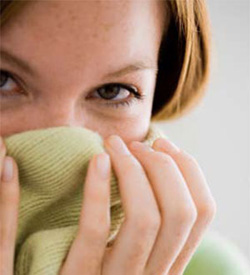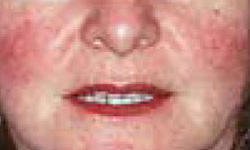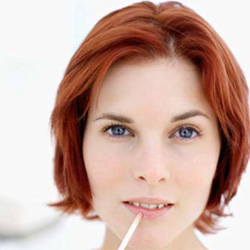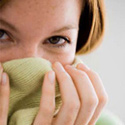Suffering From Rosacea?
Are you a flusher? A blusher? Tired of that chronic redness on your face or your adult acne? You may very well have a treatable condition called rosacea.
Rosacea, or the “Curse of the Celts” as it is historically known, tends to plague those of northern European heritage unequally higher than other backgrounds. It is a dirt-common disease that is just beginning to be understood by modern medicine.
Rosacea is the fifth most common diagnosis by a dermatologist, an estimated 14 million Americans grapple with it on a daily basis. Chances are you know someone with rosacea. It could be that friend who turns beet red after a glass of wine; the middle-aged woman with the sudden onset of acne; or the older gentleman with an increasingly bulbous nose. Rosacea presents in quite a broad spectrum of flavors across individuals.

Signs Of Rosacea
Most rosacea sufferers experience central facial redness of the cheeks, chin, nose, and forehead. It tends to run a cyclical course—going through periods of remission and flares seemingly with a mind of its own. Although it may arise at any age, most patients develop it after the age of the thirty. It is more common in women but tends to be more severe in men. Often unsightly bumps and pimples may erupt in these areas. Many people that have been labeled as having “adult acne” in fact have rosacea. A comment I often hear from patients is, “Gee doc. I never had acne as a teenager. And now my face looks like this! It doesn’t seem fair!” Indeed it does not. To add to the frustration, typical over-the-counter acne treatments often make it worse.
Patients have shared with me that they avoid public places and have canceled social obligations because of it. The fear of turning ruby red gives many people the red light in life. The National Rosacea Society reports that 70% of rosacea patients state it has lowered their self-confidence and self-esteem. The tycoon J.P. Morgan was so ashamed of his rosacea that he reportedly went to great lengths not be photographed later in life. There is a famous photo of J.P., with rosacea fully-flared, frantically trying to wave off a photographer—a second too late apparently. President Bill Clinton’s rosacea was noticeably troublesome throughout his tumultuous terms in office. As President, he didn’t have the luxury of hiding from the camera. And I suspect the rosy-cheeked Santa Claus has never been photographed because of it (I’ve never treated him as a patient but I imagine he suffers from rosacea). On the other hand, the artist Rembrandt evidently felt no shame in the disease, as his self portrait candidly depicts features of rosacea in all its glory.

As if the chronic redness and pimples weren’t ghastly enough, fine blood vessels can often be seen spider webbing across these areas of redness.
Some people experience a burning or stinging sensation when they go outside into the sun. Contrary to popular belief, they are probably not vampires but merely rosacea suffers. The skin in rosacea can become so sensitive that even the gentlest of cleansers and sunscreens are not tolerated well. It can result in thickening of the nose and cheeks that can create baggy and swollen appearing skin, like the texture of an orange peel. Chronic redness of the eyes or a gritty feeling in the eyelids can be other symptoms but are less common.
Fear Of The Bulbous Nose From Rosacea
Perhaps the most-feared aspect of rosacea is the potential development of the bulbous nose. Medically named rhinophyma, it is more commonly known as “The W.C. Fields nose”. For those of you old enough to remember Mr. Fields, you will recall he was known for his love of women and especially his love of alcohol. This has led to a common misperception that rosacea is a sign of alcohol abuse. In France it was known as the “pustule de vin” or the “pimples of wine” in the 14th century. While we understand alcohol is one of many triggers for causing flares, it is not the underlying cause. Many people feel stigmatized and believe others see them as alcoholics or closet drinkers simply because they have rosacea. For the record: Alcohol does not cause rosacea. The serving of a cold sorbet or ice chips at wine tasting events is supposedly offered to help those who flush and blush after even the smallest of sips.

Some Fact About Rosacea
I’m certain the “rose” in rosacea probably refers to the red color of an actual rose, but I cannot find any proof of this. A good description of rosacea appears in Chaucer’s Canterbury Tales and Shakespeare references it in Henry V. Otherwise, there are not many historical accounts of the disease.
Rosacea is simply not “adult acne”. The pathogenesis differs from regular acne in that bacteria does not play a central role like it does in teenage acne. Rosacea is more of an inflammatory process that causes the skin’s blood vessels to over-dilate. Researchers have noticed a correlation between microscopic mites, called demodex, that inhabit the pores and rosacea severity. Currently this is the classic “chicken and the egg” puzzle. Some believe the mites spawn the inflammation while others feel they are simply opportunists or innocent bystanders. There has also been some interesting work recently in the link between rosacea and the overgrowth of bacteria in the small intestine.
There Is No Need To Suffer From Rosacea
There is no cure for rosacea, but you need not suffer from it. Learning to identify and control what triggers your rosacea is the key to success. Dermatologists have many excellent treatments to offer. But its management needs to be a partnership between the doctor and patient. By far, sun exposure is public enemy number one to rosacea sufferers. Emotional stressors and hot weather are close seconds. Wind, heavy exercise, alcohol, fruits, hot and spicy foods, and changes in humidity are also responsible for many flares. Rarely, marinated meats and diary products can also be problematic. In a cruel twist of fate, chocolate and tomatoes (technically a fruit) make the list also.
Get Help For Rosacea
I would encourage anyone who believes they may have rosacea to see a dermatologist and visit the National Rosacea Foundation website at www.rosacea.org. Even though we all look better in sepia or black and white photos, someone in your life is going to want a full color picture of you. Shame has no place on your face. And if you happen to see Santa now that Christmas is over, let the big guy know he doesn’t have to suffer that facial redness…just don’t tell Rudolph!
If you or someone you know suffers from Rosacea or its symptoms, please schedule an appointment with us today. Click here for an appointment to get help for Rosacea.

